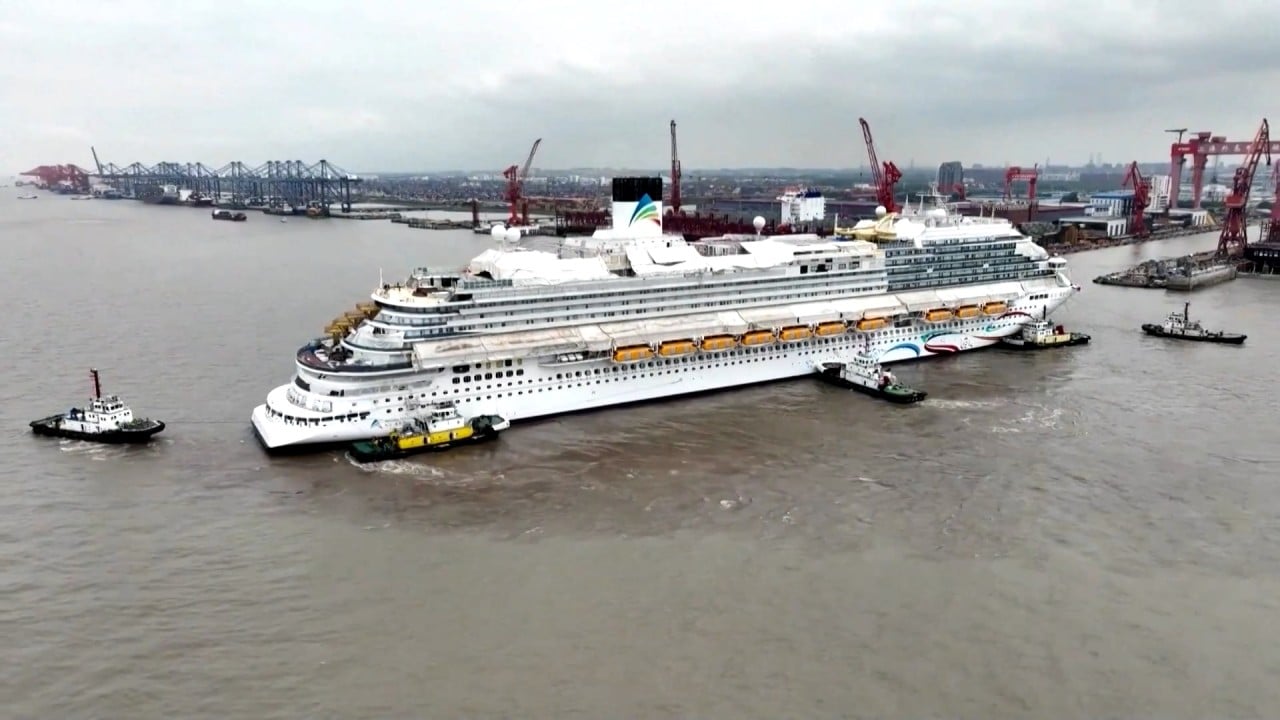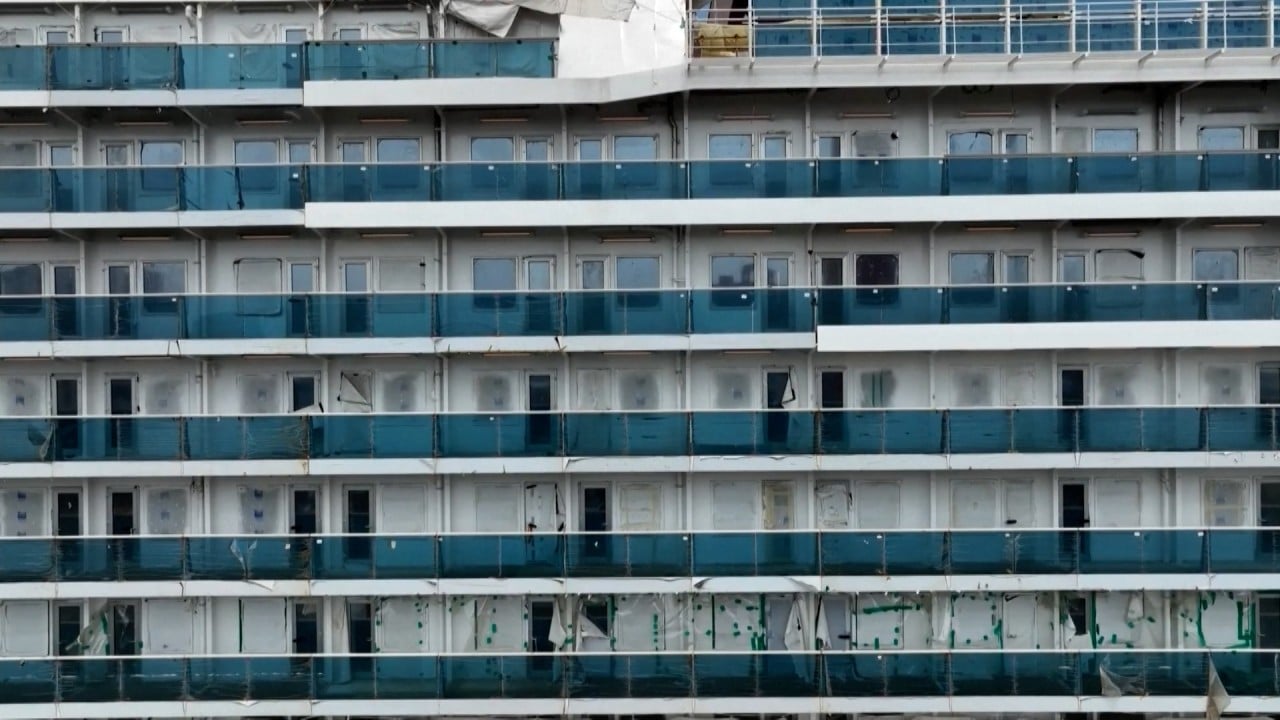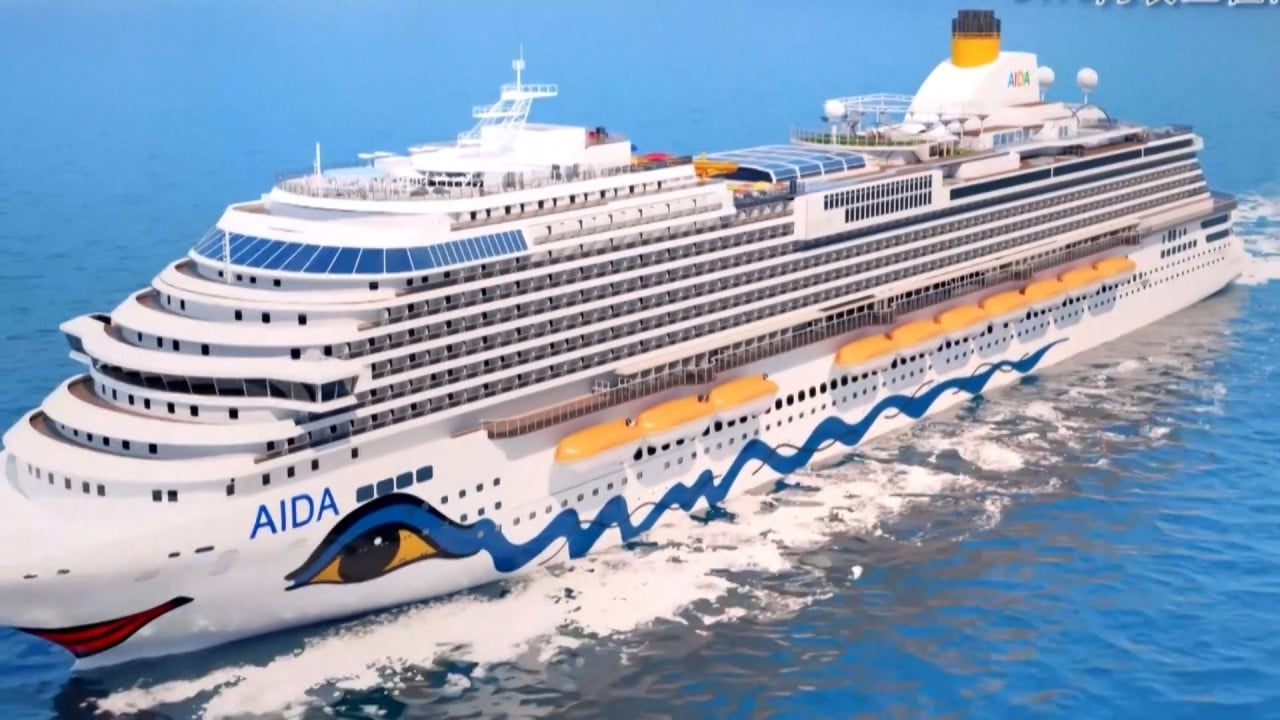
02:19
China’s first home-grown large cruise ship set to begin sea trials
Explainer | What is China’s first home-grown large cruise liner, and why is it a breakthrough?
- Adora Magic City, a 135,500-tonne liner built by Shanghai Waigaoqiao Shipbuilding, undocked in Shanghai on June 6 ahead of a series of sea trials
- It represents another critical step towards boosting self-reliance in critical industries following the maiden flight of the C919 home-grown passenger jet
It marks the nation’s first foray into a sector long dominated by European shipyards, while also representing a critical step in efforts to reduce its reliance on external sources.
What is China’s first large cruise ship?
Originally known as the H1508, construction began on the vessel in October 2019.
Now named Adora Magic City, the 135,500-tonne liner has been built by Shanghai Waigaoqiao Shipbuilding – a subsidiary of the state-owned China State Shipbuilding Corporation.
The state-owned firm was contracted to make the ship in conjunction with Italian shipbuilding giant Fincantieri.
It can accommodate up to 5,246 passengers in more than 2,000 rooms.
The length of the cable layout in the vessel spans 4,200km (2,610 miles). In comparison, the distance from China’s easternmost city of Fuyuan in Heilongjiang province to its westernmost city of Kashgar in Xinjiang is about 4,650km as the crow flies.
Adora Magic City will make two trial trips in July and August, Waigaoqiao confirmed at the end of May.
Will China build more large cruise ships?
China is also currently building a second cruise ship, known as the H1509.
Waigaoqiao Shipbuilding started construction of the second ship in August 2022, and it will be 17.4 metres (57 feet) longer and have 19 more guest rooms than its sister ship.
It is expected to be delivered in 2025.
Who will operate China’s large cruise ships?
The orders for the two cruise ships were placed by a joint venture between China State Shipbuilding Corporation and Carnival, one of the world’s largest cruise operations.
Why is China’s first cruise ship a big deal?
China is the largest shipbuilding nation in the world, with a combined deadweight tonnage of 39.7 million in 2021 and 37.86 million in 2022, according to the China Association of the National Shipbuilding Industry.
The 2022 figure represented 47.3 per cent of the world’s total, according to the association.
But large cruise ships had remained the only type of advanced, high-value-added ships that China had yet to produce.
The delivery of the H1508 and ongoing construction of the H1509 represent breakthroughs in both China’s shipbuilding industry and its advanced-manufacturing efforts in general, as the nation continues to take critical steps towards boosting its self-reliance in critical industries.
Through the making of this very first large cruise ship, we hope to build a wholesome industrial system and cultivate a cruise culture
Large cruise ships, often called floating cities, are among the most difficult and intricate ships to make, due to the required technologies and the complexity of the manufacturing process.
The joint ventures between the China State Shipbuilding Corporation, Carnival and Fincantieri also encapsulate China’s ambitious foray into the cruise ship industry.
“Previously, large cruise ships were nearly exclusively made in Europe, and the entire industry chain is located there. Now, with the first domestically made cruise liner, scientific institutions in China have started developing our own parts,” Yang Xin, deputy head of Waigaoqiao’s cruise project department, said during CCTV’s live broadcast of the undocking ceremony.
“Through the making of this very first large cruise ship, we hope to build a wholesome industrial system and cultivate a cruise culture.”
Why is it so difficult to build cruise ships?
Building a cruise ship is an intricate process requiring millions of parts from thousands of suppliers.
Supplies and materials used on cruise ships require unique specifications. For instance, glass must be thinner, and carpets and curtains need to be lighter. Lifts and central air conditioning must also meet certain qualities to cater to thousands of passengers and comply with international cruise industry standards.
What is China’s C919 passenger jet and can it take on Airbus, Boeing?
Making a cruise ship and developing an industry from scratch is no small undertaking for China. Few domestic suppliers have the necessary experience to make specific cruise ship parts, nor are they familiar with international industry standards, so most supplies assembled on the ship need to be imported, adding to the already high cost.
As European shipyards have dominated the cruise-ship-building industry for decades, the international standards were essentially established and evolved there.
Materials, such as steel angles, are sometimes set according to the standards of local manufacturers, and it could be very difficult for Chinese factories to change their standards.
It would be extremely challenging and time-consuming for Chinese shipyards to adopt the standards and make parts from scratch. So, they have little choice but to buy materials directly from Europe, study them, and aim to bridge the technical gap while incubating a domestic supply chain that will eventually support local manufacturing.
In addition to the manufacturing difficulties, the procurement of certifications also presents a huge challenge.
The global voyage of cruise ships requires that they adhere to the specific safety and environmental standards of each country where the ships make port calls. This includes everything from alarms to evacuation and sewage systems.
Why is China entering the cruise ship industry now?
The cruise-ship industry is a huge market.
Since Costa Cruises became the first international cruise line to set sail from China, in 2006, its cruise industry has grown exponentially.
Cruises have become increasingly popular in big metropolises such as Shanghai, Tianjin and Guangzhou, as well as relatively smaller ones such as Chengdu, Qingdao and Xiamen.
China has been seen for years as having the potential to become the world’s largest cruise market, possibly by 2030, with between 8 million and 10 million patrons per year, according to the most recent data available estimates by the Shanghai International Shipping Institute from 2015.
According to a 2018 directive on boosting cruise travel by 10 ministries, China’s cruise market is expected to see 14 million patrons per year by 2035.
Before the coronavirus pandemic, Chinese travellers used to be the biggest contributors to global tourism. A total of 155 million Chinese tourists travelled abroad in 2019, according to the Ministry of Culture and Tourism, and they spent about US$254.6 billion a year. That equates to an average of US$1,643 per traveller.





